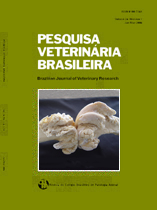 |
|
|
|
Year 2014 - Volume 34, Number 9
|

|
Bacterial pneumonia in red-footed tortoise (Chelonoidis carbonaria): Clinical aspects, microbiological, radiological and therapeutic, 34(9):891-895
|
ABSTRACT.- Silveira M.M., Morgado T.O., Lopes E.R., Kempe G.V., Correa S.H.R., Godoy I., Nakazato L. & Dutra V. 2014. [Bacterial pneumonia in red-footed tortoise (Chelonoidis carbonaria): Clinical aspects, microbiological, radiological and therapeutic.] Pneumonia bacteriana em jabuti-piranga (Chelonoidis carbonaria): aspectos clínicos, microbiológicos, radiológicos e terapêutica. Pesquisa Veterinária Brasileira 34(9):891-895. Departamento de Clínica Médica Veterinária, Faculdade de Agronomia, Medicina Veterinária e Zootecnia, Universidade Federal de Mato Grosso, Av. Fernando Corrêa da Costa s/n, Coxipó, Cuiabá, MT 78068-900, Brazil. E-mail: valdutra@ufmt.br
Pneumonia is a common respiratory disease in clinical of reptiles. Infectious agents are capable of causing primary pneumonia in reptiles maintained in captivity, but in most cases are secondary to problems of management, hygiene and nutrition. The aim of this study was to report the occurrence of bacterial pneumonia in red-footed tortoise (Chelonoidis carbonaria), and describe the clinical, microbiologic, radiographic and therapeutic management. The animal showed signs of respiratory disorders and has been described in the clinical history before diagnosis of pneumonia. The radiographic findings were suggestive of pneumonia/pulmonary edema. Based on the displayed radiographic examination and clinical signs began treatment with administration of chloramphenicol (40mg/kg/SID/IM) for ten days. Were isolated Klebsiella spp. and Citrobacter spp. bacterial culture done collecting endotracheal lavage. Both with multiple antibiotic resistance profile tested. Treatment protocol was instituted using gentamicin (5mg/kg/IM) applications into seven intervals of 72h. There was improvement in clinical signs of the animal, but the presence of nasal secretion was still observed. New radiographic examination, demonstrating slight decrease in the opacity of the right lung field and no significant change in the left lung field in craniocaudal projection was performed. Because of the persistence of clinical signs presented new collection endotracheal material was performed, and there was isolation of Citrobacter spp. and Enterobacter spp. From the results obtained in the antibiogram, was instituted new protocol with the use of amikacin (2.5mg/kg/IM) applications into seven intervals of 72h. After antibiotic therapy, other radiological examination was performed, and showed satisfactory reduction in pulmonary function and clinical signs. |
| |
|
|
| |
|
 |